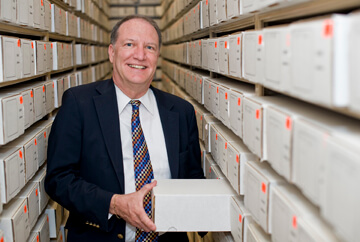Purdue Profiles: Robert Browning

Robert Browning, associate professor of political science and communication and director of C-SPAN Archives. (Purdue University photo/Andrew Hancock)
When Robert Browning, associate professor of political science and communication, began teaching at Purdue in 1981, his father, a C-SPAN enthusiast, urged him to watch the coverage, saying it would benefit the courses he taught.
Years later, after a chance meeting with C-SPAN founder Brian Lamb and a discussion about the useful resources C-SPAN could provide, Browning became the founding director of C-SPAN Archives, which is housed in Purdue
Research Park.
What does your job as director of C-SPAN Archives entail?
We index all C-SPAN programming -- three networks that run 24 hours a day. We digitize all the footage and make it available on our website for people to view and use in publications or online. For instance, if you wanted to find out the first time Condoleezza Rice was on C-SPAN or how many times a congressman was on the floor, you type in their name, and it comes up.
There are 8,000 hours of new material that come in every year. We have three people who work every day as indexers, and we employ a number of student interns who do supplemental work for us.
I manage that whole operation. I also make decisions on licensing if people want to use material in things like movies or documentaries.
What kinds of movies or documentaries have you worked with?
The latest one that needed a license was “The Real Housewives of D.C.” In the old television series “The West Wing,” they used C-SPAN videos to create a realistic scene. Sometimes shows will just license our logo to make something look as if a character is on C-SPAN.
C-SPAN is comfortable with that today because the name has become such a successful brand, and people recognize it. C-SPAN recognizes that as gavel-to-gavel coverage.
How did the idea for these archives come about?
Brian Lamb, who is a Purdue graduate, and I had a chance meeting with some other professors in 1986. The whole idea about using C-SPAN to teach and research came up, but all of us professors asked, “If there’s no archive, how can we use it?”
Brian suggested that Purdue create that archive, and we did. We were part of Purdue from 1987 to 1998. Now we are housed at Research Park but are completely run by C-SPAN.
Is there any overlap between your work as a professor and the work you do with the archives?
I use raw material from the archives for my teaching. I use lots of clips, and I’ve had the students do projects. Last semester they created a blog and used material from C-SPAN to illustrate concepts and processes. Both the students and I use the constant influx of video that comes in.
Does this kind of archive change the way people do politics?
It shows up in campaign ads, in articles, blogs and newspapers. There have been several cases this year where people have said one thing in the past and are saying something different today. So the opponents show that or a newspaper or publication that is opposed to a candidate comes out with that information. In some sense, with the archive today, there’s no deniability. What you’ve said on C-SPAN for the last 24 years is all on the record.
People are more sensitive to that. If someone is running for office against someone or if someone is researching someone who is running for office, they almost immediately go to our archive to find out what exists on this person.
Christine O’Donnell is a good example. We had three or four interviews that she gave over the past 10 years where she was just a publicist for conservative causes, but she was on C-SPAN, so we had the footage.
What is your favorite part of working at the archives?
The technology we use to do new things all the time. The project has changed so much over 24 years. At the beginning it was almost like we were inundated with information. Now we’re digital, we have faster computers and we are able to stay on top of all the information.
It’s always a challenge to do more and more with that information, to gather more and more, to index better and in more ways. It used to be that all we could really do was get somebody to the right videotape. Today, we can actually index to individual speakers that jump right to where you want to go.
Have you experienced any memorable moments because of your work?
Recently the chief information officer of the United States at the White House called me. They found out about us from an event that C-SPAN covered, so they sent word that wanted to meet the people from the archives. Because we’re so successful at managing information, they wanted to learn how we did things and see what the federal government could use.
More information
Visit c-spanvideo.org for more on the C-SPAN Archives.
Each Tuesday, Purdue Profiles gives an inside look at the people on our campus. If you would like to suggest someone to be featured in Purdue Profiles, contact Valerie O'Brien at PurdueToday@purdue.edu or 49-49573.
